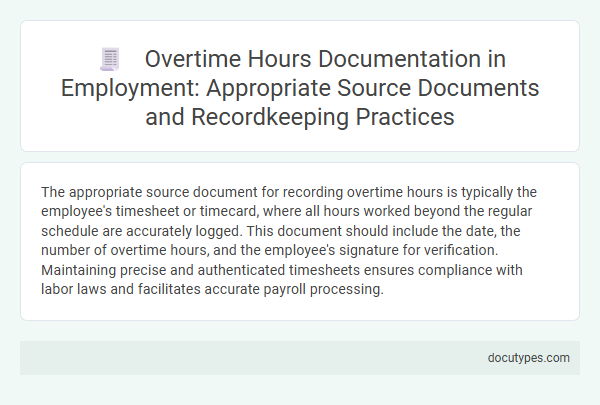The appropriate source document for recording overtime hours is typically the employee's timesheet or timecard, where all hours worked beyond the regular schedule are accurately logged. This document should include the date, the number of overtime hours, and the employee's signature for verification. Maintaining precise and authenticated timesheets ensures compliance with labor laws and facilitates accurate payroll processing.
Introduction to Overtime Hours Documentation
Overtime hours documentation is essential for accurate payroll processing and compliance with labor laws. The appropriate source document for recording overtime hours is typically the employee timesheet or time card, which captures the exact hours worked beyond regular schedules. Employers rely on these records to verify and authorize overtime payments efficiently.
Legal Requirements for Overtime Recordkeeping
| Aspect | Details |
|---|---|
| Source Document | Timesheets, electronic time-tracking systems, and punch cards are commonly accepted documents for recording overtime hours. |
| Legal Requirements | Most labor laws mandate accurate and verifiable records of all hours worked, including overtime, to ensure compliance with wage and hour regulations. |
| Recordkeeping Duration | Employers are typically required to retain overtime records for a minimum of 3 to 5 years, depending on regional labor laws. |
| Accuracy Standards | Records must clearly delineate regular and overtime hours, reflecting start and end times verified by both employee and employer. |
| Employee Responsibility | You should verify the accuracy of your recorded overtime hours to protect your rights under labor regulations. |
Types of Source Documents for Overtime Verification
Overtime hours must be accurately recorded using appropriate source documents to ensure compliance with labor regulations and proper payroll processing. Common source documents include timesheets, biometric time records, and electronic punch cards.
Timesheets provide a manual record of hours worked, often verified by supervisors. Electronic timekeeping systems capture clock-in and clock-out data automatically, enhancing accuracy for overtime verification.
Time Sheets and Electronic Timekeeping Systems
Overtime hours are best recorded using accurate and reliable source documents. Time sheets and electronic timekeeping systems provide a clear record of hours worked beyond regular schedules.
Time sheets allow manual entry of hours, offering flexibility for recording overtime in various work environments. Electronic timekeeping systems automate this process, ensuring precision and reducing errors in tracking overtime hours for payroll purposes.
Payroll Records and Their Role in Overtime Tracking
What is the appropriate source document for recording overtime hours in employment? Payroll records serve as the primary and most reliable source for tracking overtime hours worked, ensuring accuracy in compensation. These records document employee time logs, overtime calculations, and wage adjustments, providing comprehensive data for payroll processing and compliance.
Supervisor Approvals and Authorization Forms
The appropriate source document for recording overtime hours is typically a supervisor approval or authorization form that validates extra work beyond regular schedules. These documents ensure accurate tracking and compliance with labor regulations.
- Supervisor Approval Forms - These forms confirm that a supervisor has reviewed and authorized the employee's overtime work.
- Authorization Documentation - Formal records or electronic entries serve as official proof of granted overtime hours.
- Compliance Verification - Proper source documents help maintain adherence to company policies and labor laws.
Your employer relies on these source documents to process accurate overtime payments and maintain transparent records.
Employee Self-Reporting: Best Practices
The appropriate source document for recording overtime hours often relies on employee self-reporting to ensure accuracy and accountability. Best practices include using standardized timesheets or digital time-tracking systems where employees log their overtime hours promptly. Clear guidelines and regular audits help maintain data integrity and compliance with labor regulations.
Retention Periods for Overtime Documentation
The appropriate source document for recording overtime hours typically includes timesheets, punch cards, or digital time tracking systems that accurately reflect hours worked beyond regular schedules. Employers must retain overtime documentation for a legally mandated period to ensure compliance with labor laws and facilitate audits.
- Timesheets - These provide detailed records of actual hours worked and must be maintained as evidence of overtime.
- Retention Periods - Federal regulations often require keeping overtime records for at least three years.
- Compliance Verification - Your documentation should be stored securely and accessible to verify overtime claims during inspections or disputes.
Common Errors in Overtime Recordkeeping
Accurate recording of overtime hours is critical for compliance with labor laws and ensuring proper employee compensation. The appropriate source document for recording overtime hours is typically the employee timesheet or timecard, which must be meticulously maintained to avoid errors.
- Failure to Capture All Overtime - Omitting overtime hours from timesheets results in underpayment and potential legal consequences.
- Inconsistent Time Tracking Methods - Using varying or manual tracking systems leads to discrepancies and inaccurate overtime calculation.
- Delayed Submission of Time Records - Late recording or approval of overtime hours causes payroll processing delays and employee dissatisfaction.
What Is the Appropriate Source Document for Recording Overtime Hours? Infographic

